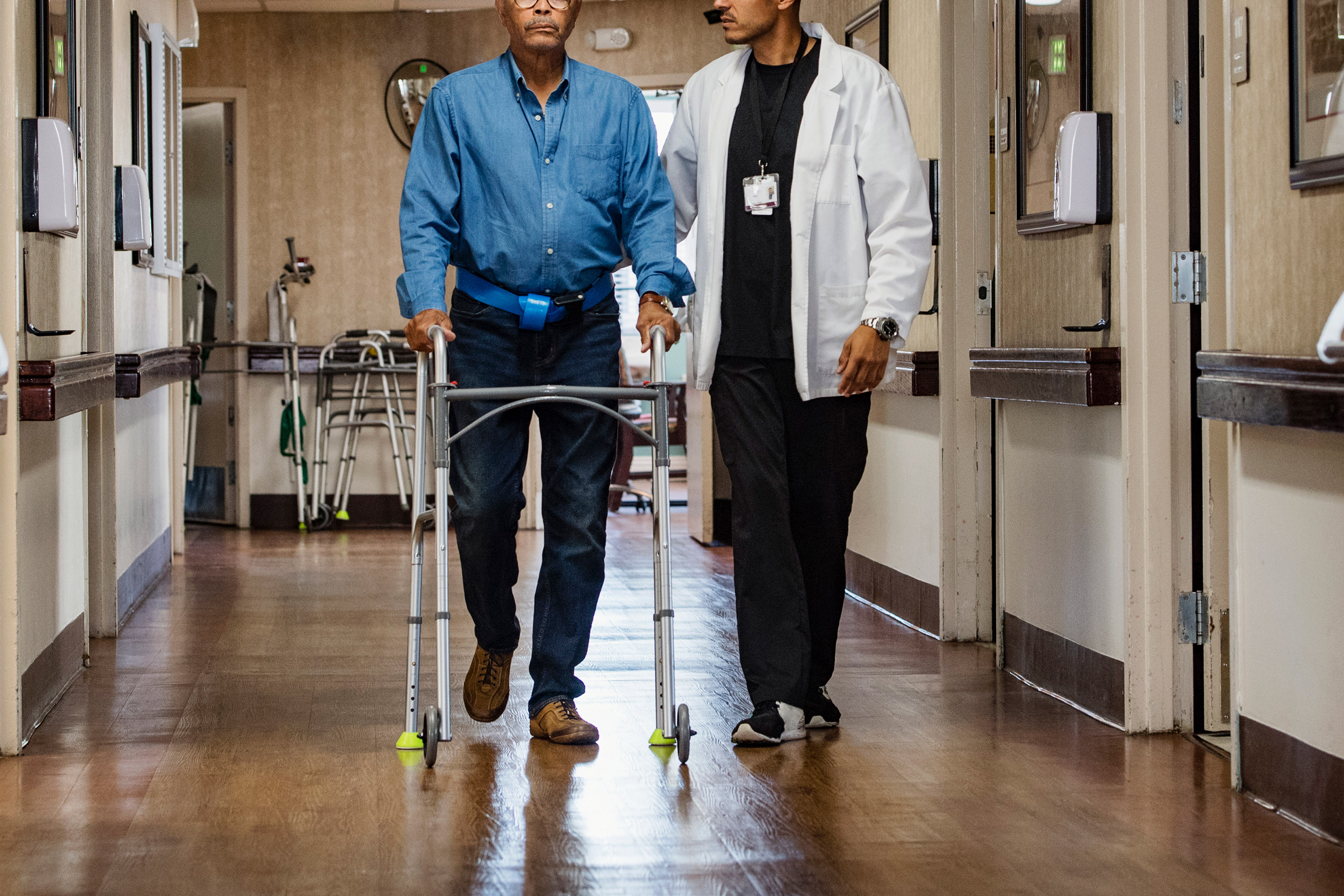
Pile of objects accumulated in someone's home including clothing and outdoor equipment, household objects, and old electronics. trekandshoot/iStock / Getty Images Plus hide caption
toggle caption
trekandshoot/iStock / Getty Images Plus
A dozen people seated around folding tables clap heartily for a beaming woman: She's donated two 13-gallon garbage bags full of clothes to a Presbyterian church, including several Christmas sweaters and a couple of pantsuits.
To many, a closet cleanout might not seem a significant accomplishment. But as the people in this Sunday-night class can attest, getting rid of stuff is agonizing for those with hoarding disorder.
A version of this story first appeared in How We Care from Spotlight PA, an independent, nonpartisan newsroom that drives positive change in Pennsylvania.
People with this diagnosis accumulate an excessive amount of things, such as household goods, craft supplies, even pets. In extreme cases, their homes become so crammed that it's only possible to move between rooms through narrow pathways.
These unsafe conditions can also lead to strained relationships.
"I've had a few relatives and friends that have condemned me, and it doesn't help," said Bernadette, a 72-year-old Pennsylvania woman who has struggled with hoarding since retirement and no longer allows guests in her home.
Bernadette is not alone. People who hoard are often stigmatized as lazy or dirty. NPR agreed to only use the first names of the people interviewed for this story so they could speak freely.
Due to demographic shifts, hoarding disorder is a growing public health concern. Effective treatments are scarce. And because hoarding can require expensive interventions that drain municipal resources, more funding and expertise is needed to support those with this diagnosis before this issue of clutter grows into a crisis.
For Bernadette, the 16-week course she's currently taking is helping her turn over a new leaf.
The program doubles as a support group and is provided through Fight the Blight. The Westmoreland County, Pennsylvania, organization started offering the course at a local Masonic Temple after founder Matt Williams realized there weren't hoarding-specific mental health services in the area.
Fight the Blight uses a curriculum based on cognitive behavioral therapy to help participants build awareness around what fuels their hoarding. People learn to be more thoughtful about what they choose to purchase and save. And they create strategies so that decluttering doesn't become overwhelming.
But perhaps more importantly, attendees say they've formed a community knitted together through the shared experience of a psychiatric illness that has high rates of social isolation and depression.
"You get friendship," said Sanford, who attends the course with Bernadette.
After a lifetime of judgment and recrimination, these friendships have become an integral part of the changes that might help them eventually clear out the clutter.
Clutter catches up to Baby Boomers
Hoarding disorder is a mental illness that's estimated to affect more than 2.5% of the general population — a higher rate than schizophrenia.
It was previously considered a subtype of obsessive-compulsive disorder, but in 2013 it was given its own diagnostic criteria in the Diagnostic and Statistical Manual of Mental Disorders, the DSM-5.
The biological and environmental factors that drive hoarding are not well understood. Symptoms usually appear during the teenage years and are more severe among older adults. That's partly because people have had more time to acquire things, said Kiara Timpano, a University of Miami psychology professor.
"All of a sudden you have to downsize this huge home with all the stuff and so it puts pressures on individuals," she said. In Bernadette's case, her clutter includes a collection of VHS tapes, and spices in her kitchen that she said date back to the Clinton Administration.

Eva Williams, wife of Fight the Blight founder Matt Williams, works to clean the basement of someone with hoarding disorder. The homeowner decided to clear out their home in Youngwood, Pennsylvania, after attending Fight the Blight's course and support group.
Matt Williams/Fight the Blight
hide caption
toggle caption
Matt Williams/Fight the Blight
But it's more than just having the decades to stockpile possessions; the urge to accumulate strengthens with age, according to Catherine Ayers, a psychiatry professor at the University of California San Diego.
Researchers are working to discern why. Ayers and Timpano theorize that age-related cognitive changes — particularly those in the frontal lobe that regulate impulsivity and problem-solving — might exacerbate the disorder.
"It is the only mental health disorder, besides dementia, that increases in prevalence and severity with age," said Ayers.
As the U.S. population ages, hoarding presents a growing public health concern: Some 1 in 5 U.S. residents are baby boomers, all of whom will be 65 or older by 2030.
This population shift will require the federal government to address hoarding disorder — among other age-related issues — that it has not previously prioritized, according to a report released in July by the majority staff of the U.S. Senate Special Committee on Aging, chaired by outgoing U.S. Sen. Bob Casey (D-Pa.)
Health hazards of hoarding
Clutter creates physical risks.
A cramped and disorderly home is especially dangerous for older adults because falls that result in fractures and broken bones increase with age. And having too many things in one space is a fire hazard.
Earlier this year, the National Fallen Firefighters Foundation wrote to Casey's office to explain that, "hoarding conditions are among the most dangerous conditions the fire service can encounter." The group also said that cluttered homes delay emergency care and increase the likelihood of a first responder being injured on a call.
The Bucks County, Pennsylvania commissioners told Casey that hoarding-related mold and insects can spread to adjacent households, endangering the health of neighbors.

Tristen Williams helps remove clutter from the home of someone with hoarding disorder in Greensburg, Pennsylvania. The homeowner decided to ask for help with the cleanout after attending a course and support group offered by the nonprofit Fight the Blight, founded by Williams' father.
Matt Williams/Fight the Blight
hide caption
toggle caption
Matt Williams/Fight the Blight
Due to these safety concerns, it might be tempting for a family member or public health agency to quickly empty someone's home in one fell swoop.
That's a bad idea, and it can backfire, said psychologist Kiara Timpano. This approach fails to address people's underlying issues and can be traumatic.
"It can really disrupt the trust and make it even less likely that the individual is willing to seek help in the future," she explains.
It's more effective to help people build internal motivation to change and help them identify goals to manage their hoarding.
For example, at the Fight the Blight class, a woman named Diane told the group she wanted a cleaner home so she can invite people over and not feel embarrassed.
A man named Sanford explained he is learning to keep his documents and record collection more organized.
Bernadette wants to declutter her bedroom so she can start sleeping in it again. Also, she's glad she cleared enough space on the first floor for her cat to play.
"Because now he's got all this room," she said. "He goes after his tail like a crazy person."
Ultimately, the home of someone with hoarding disorder might always be a bit cluttered, and that's OK. The goal of treatment is to make their space healthy and safe, said Timpano, not to earn Marie Kondo's approval.
Lack of effective treatment leaves people with few options
A 2020 study found that hoarding correlates with homelessness, and those with the disorder are more likely to be evicted.
Housing advocates argue that under the Fair Housing Act, tenants with this diagnosis are entitled to reasonable accommodations. This might include allowing someone time to declutter a home and seek therapy before forcing them to leave their home.
But as outlined in the Senate aging committee's report, a lack of resources limits efforts to carry out these accommodations.

Items removed by nonprofit Fight the Blight from a home in Greensburg, Pennsylvania. The homeowner decided to clear out their home after attending Fight the Blight's workshop. Matt Williams/Fight the Blight hide caption
toggle caption
Matt Williams/Fight the Blight
Hoarding is difficult to treat. In a 2018 study led by Ayers, the UC-San Diego psychiatrist, researchers found that people coping with hoarding need to be highly motivated and often require substantial support to remain engaged with their therapy.
This is exacerbated by a shortage of clinicians with the expertise to specifically treat hoarding disorder, said Janet Spinelli, the co-chair of Rhode Island's hoarding task force.
Could changes to federal policy help?
Pennsylvania's outgoing senator, Bob Casey, has advocated for more education and technical assistance for hoarding disorder.
In September, Sen. Casey called for the Substance Abuse and Mental Health Services Administration to develop training, assistance and guidance for communities and clinicians. He also said the Centers for Medicare and Medicaid Services should explore ways to cover evidence-based treatment and services.
This might include increased Medicare funding for mobile crisis services to go to people's homes, which Spinelli said is one way to connect someone to therapy.
Another strategy would involve allowing Medicaid and Medicare to reimburse community health workers who assist patients with light cleaning and organizing — research has found that many who hoard struggle with categorization tasks.
Williams, of Fight the Blight, agrees that in addition to more mental health support, there needs to be taxpayer-funded services that help people to address their clutter.
When someone in the group reaches a point where they want to declutter their home, Fight the Blight helps them start the process of cleaning, removing and organizing.
This service is free to those earning less than 150% of the federal poverty level. People making above that threshold can pay for assistance on a sliding scale; costs vary depending on the size of a property and severity of the hoarding.
Also, Spinelli thinks Medicaid and Medicare should fund more peer-support specialists for hoarding disorder. These mental health workers draw on their own life experiences to help others with similar diagnoses. For example, peer counselors could lead classes, like what's offered by Fight the Blight.
Bernadette and Sanford believe that courses like the one they're in should be available all over the U.S.
To those who are just starting to address their own hoarding, Sanford advises that it takes patience and persistence.
"Even if it's a little job here, a little job there," he said, "that all adds up."
This story comes from NPR's health reporting partnership with KFF Health News.

![Healthy Blueberry Protein Muffins [gluten-free + no added sugar]](https://i0.wp.com/healthyhelperkaila.com/wp-content/uploads/2024/12/BlueberryMuffinFeatured.png?fit=1536%2C1528&ssl=1)







![Healthy Peanut Butter Banana Protein Pancakes [dairy-free + gluten-free]](https://i0.wp.com/healthyhelperkaila.com/wp-content/uploads/2024/11/PBBananaPancakesFEATURED.png?fit=1531%2C1536&ssl=1)









 English (US) ·
English (US) ·